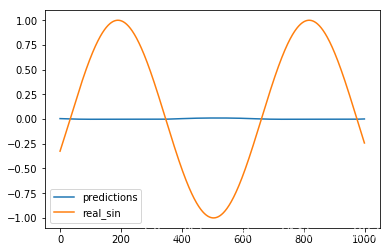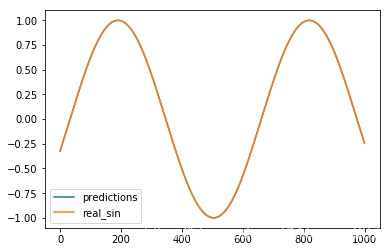import numpy as np
import tensorflow as tf
import matplotlib as mpl
import matplotlib.pyplot as plt
HIDDEN_SIZE = 30
NUM_LAYERS = 2
TIMESTEPS = 10
TRAINING_STEPS = 10000
BATCH_SIZE = 32
TRAINING_EXAMPLES = 10000
TESTING_EXAMPLES = 1000
SAMPLE_GAP = 0.01
def generate_data(seq):
X = []
y = []
for i in range(len(seq) - TIMESTEPS):
X.append([seq[i: i + TIMESTEPS]])
y.append([seq[i + TIMESTEPS]])
return np.array(X, dtype=np.float32), np.array(y, dtype=np.float32)
def lstm_model(X, y, is_training):
cell = tf.nn.rnn_cell.MultiRNNCell([
tf.nn.rnn_cell.BasicLSTMCell(HIDDEN_SIZE)
for _ in range(NUM_LAYERS)])
outputs, _ = tf.nn.dynamic_rnn(cell, X, dtype=tf.float32)
output = outputs[:, -1, :]
predictions = tf.contrib.layers.fully_connected(
output, 1, activation_fn=None)
if not is_training:
return predictions, None, None
loss = tf.losses.mean_squared_error(labels=y, predictions=predictions)
train_op = tf.contrib.layers.optimize_loss(
loss, tf.train.get_global_step(),
optimizer="Adagrad", learning_rate=0.1)
return predictions, loss, train_op
def run_eval(sess, test_X, test_y):
ds = tf.data.Dataset.from_tensor_slices((test_X, test_y))
ds = ds.batch(1)
X, y = ds.make_one_shot_iterator().get_next()
with tf.variable_scope("model", reuse=True):
prediction, _, _ = lstm_model(X, [0.0], False)
predictions = []
labels = []
for i in range(TESTING_EXAMPLES):
p, l = sess.run([prediction, y])
predictions.append(p)
labels.append(l)
predictions = np.array(predictions).squeeze()
labels = np.array(labels).squeeze()
rmse = np.sqrt(((predictions - labels) ** 2).mean(axis=0))
print("Root Mean Square Error is: %f" % rmse)
plt.figure()
plt.plot(predictions, label='predictions')
plt.plot(labels, label='real_sin')
plt.legend()
plt.show()
test_start = (TRAINING_EXAMPLES + TIMESTEPS) * SAMPLE_GAP
test_end = test_start + (TESTING_EXAMPLES + TIMESTEPS) * SAMPLE_GAP
train_X, train_y = generate_data(np.sin(np.linspace(
0, test_start, TRAINING_EXAMPLES + TIMESTEPS, dtype=np.float32)))
test_X, test_y = generate_data(np.sin(np.linspace(
test_start, test_end, TESTING_EXAMPLES + TIMESTEPS, dtype=np.float32)))
ds = tf.data.Dataset.from_tensor_slices((train_X, train_y))
ds = ds.repeat().shuffle(1000).batch(BATCH_SIZE)
X, y = ds.make_one_shot_iterator().get_next()
with tf.variable_scope("model"):
_, loss, train_op = lstm_model(X, y, True)
with tf.Session() as sess:
sess.run(tf.global_variables_initializer())
print "Evaluate model before training."
run_eval(sess, test_X, test_y)
for i in range(TRAINING_STEPS):
_, l = sess.run([train_op, loss])
if i % 1000 == 0:
print("train step: " + str(i) + ", loss: " + str(l))
print "Evaluate model after training."
run_eval(sess, test_X, test_y)
Evaluate model before training.
Root Mean Square Error is: 0.690985

train step: 0, loss: 0.38567966
train step: 1000, loss: 0.0011199473
train step: 2000, loss: 0.00040280726
train step: 3000, loss: 5.9529444e-05
train step: 4000, loss: 1.1362208e-05
train step: 5000, loss: 3.1860066e-06
train step: 6000, loss: 5.6501494e-06
train step: 7000, loss: 5.7930047e-06
train step: 8000, loss: 4.321275e-06
train step: 9000, loss: 4.822319e-06
Evaluate model after training.
Root Mean Square Error is: 0.001971

内容解析
test_start = (TRAINING_EXAMPLES + TIMESTEPS) * SAMPLE_GAP
print(test_start)
100.1
test_end = test_start + (TESTING_EXAMPLES + TIMESTEPS) * SAMPLE_GAP
print(test_end)
110.2
contents = np.linspace(0, test_start, TRAINING_EXAMPLES + TIMESTEPS, dtype=np.float32)
print(contents)
print(len(contents))
count = 0
for content in contents:
print(content)
[0.00000000e+00 1.00009991e-02 2.00019982e-02 ... 1.00079994e+02
1.00089996e+02 1.00099998e+02]
10010
0.0
0.010000999
0.020001998
0.030002998
0.040003996
0.050004996
0.060005996
0.070007
0.08000799
0.09000899
0.10000999
0.11001099
0.12001199
0.13001299
0.140014
0.15001498
0.16001599
0.17001699
0.18001798
0.19001898
0.20001999
..........
..........
99.90998
99.91998
99.929985
99.93999
99.94998
99.959984
99.969986
99.97999
99.98999
99.99999
100.009995
100.01999
100.02999
100.03999
100.049995
100.06
100.07
100.079994
100.09
100.1
seq=np.sin(contents)
print(np.sin(contents))
[ 0. 0.01000083 0.02000066 ... -0.4358394 -0.4268156
-0.41774908]
X = []
for i in range(len(seq) - TIMESTEPS):
X.append([seq[i: i + TIMESTEPS]])
print(len(X))
print(X[0])
print(X[1])
10000
[array([0. , 0.01000083, 0.02000066, 0.0299985 , 0.03999333,
0.04998416, 0.05996999, 0.06994983, 0.07992266, 0.0898875 ],
dtype=float32)]
[array([0.01000083, 0.02000066, 0.0299985 , 0.03999333, 0.04998416,
0.05996999, 0.06994983, 0.07992266, 0.0898875 , 0.09984336],
dtype=float32)]
print(len(seq) - TIMESTEPS)
10000
for i in range(5):
print(i)
0
1
2
3
4
























 8541
8541











 被折叠的 条评论
为什么被折叠?
被折叠的 条评论
为什么被折叠?








